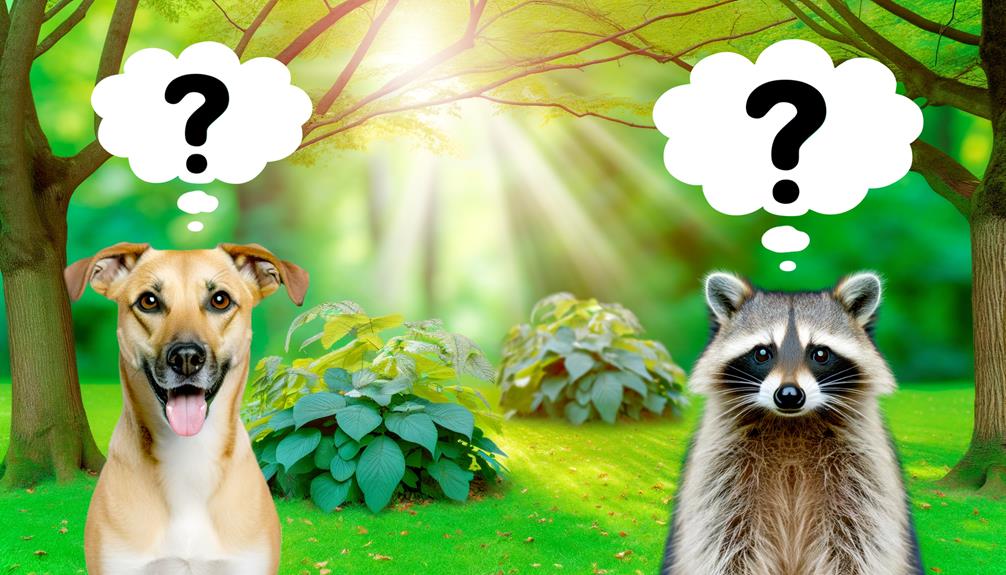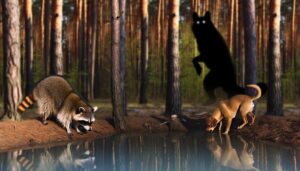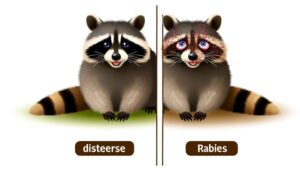Exploring Hybrid Possibilities: Can Dogs Mate with Raccoons?
A dog and raccoon mating is biologically implausible due to their distinct genetic makeup and anatomical differences. Dogs belong to the Canidae family with 78 chromosomes, whereas raccoons, part of the Procyonidae family, have 38 chromosomes.
This chromosomal disparity hinders successful mating. Additionally, their varied reproductive cycles and mating rituals due to differing species behaviors also make conception unlikely.
While the allure of hybrid animals can be intriguing, understanding the constraints and complexity of nature is fundamental. A deeper exploration of animal biology and reproduction can elaborate on the intricacies involved.

Key Takeaways
- Dogs and raccoons belong to different families, Canidae and Procyonidae respectively, indicating significant biological differences.
- The chromosomal differences between dogs (78 chromosomes) and raccoons (38 chromosomes) present a substantial barrier to successful mating.
- Mating behaviors and reproductive cycles between dogs and raccoons differ, further complicating potential mating.
- Any offspring resulting from such a union are likely to be infertile or have health complications due to genetic incompatibility.
- The risk of disease transmission and potential for conflict due to size and behavioral differences discourage cross-species mating between dogs and raccoons.
Understanding Animal Reproduction
Delving into the intricacies of animal reproduction can provide valuable insights into the biological possibilities and limitations of cross-species mating. Reproduction is typically optimized within species, with anatomical, physiological, and genetic factors working harmoniously to ensure successful procreation.
However, when two different species attempt to mate, these finely tuned processes can misalign, leading to unsuccessful or problematic outcomes. The structural incompatibility of reproductive organs, different mating behaviors, and genetic dissimilarities can all pose significant challenges.
Additionally, interspecies mating can sometimes result in sterile offspring, a phenomenon known as hybrid sterility. Therefore, while the concept of a dog mating with a raccoon might seem plausible at first glance, it is fraught with biological complications.
Exploring Dog and Raccoon Biology
To explore the possibility of a dog and raccoon mating, it is essential to investigate the unique biological characteristics of both species. Dogs, a part of the Canidae family, have a distinct genetic makeup and reproductive system compared to raccoons, who belong to the Procyonidae family. Dogs have 78 chromosomes while raccoons have 38. The difference in chromosome count is a significant barrier to successful mating.
Additionally, the reproductive cycles of these two species also differ. Female dogs, or bitches, typically come into heat twice a year, while female raccoons, or sows, have a single breeding season annually, usually in late winter or early spring. These biological differences play a vital role in the compatibility of the two species for mating.
Factors Influencing Interspecies Breeding
Understanding the factors that influence interspecies breeding is pivotal in discerning why a dog and a raccoon cannot mate successfully.
To begin with, genetic compatibility plays a significant role. Dogs and raccoons have different numbers of chromosomes, making successful fertilization impossible.
Next, behavioral differences matter. Mating rituals and body language vary among species, and misunderstandings may prevent mating.
Finally, physiological differences like size and anatomy can make mating mechanically impossible or dangerous.
While the desire for biological diversity is profoundly human, nature has its boundaries. It's imperative we respect these limits and understand the reasons behind them, not as barriers to freedom, but as necessary constraints preserving the health and integrity of all species.
Potential Outcomes of Mating
In the hypothetical scenario where a dog and a raccoon could overcome the barriers to interspecies mating, the potential outcomes would likely be unfavorable and potentially harmful for both animals.
The genetic divergence between the two species could lead to difficulties in conception, and even if successful, the offspring would likely be infertile or suffer from health problems.
The difference in size and social behaviors could also create conflicts, potentially leading to physical harm.
Additionally, both animals could be exposed to diseases that their immune systems are not prepared to fight.
Given these potential outcomes, it is clear that the idea of a dog and raccoon mating should remain purely hypothetical and not encouraged in practice.
Debunking Myths About Hybrid Animals
While it is fascinating to imagine the creation of hybrid creatures, many popular myths and misconceptions about such interspecies unions must be debunked for a more accurate understanding of animal biology. The belief that any two species can mate and produce offspring, for instance, is a widespread fallacy.
Here's a table that demystifies some common myths:
| Myth | Fact |
|---|---|
| Any two species can mate | Only species that are closely related can mate |
| Hybrid animals can always reproduce | Most hybrid animals are sterile |
| All hybrid animals are healthy | Many hybrids have health issues due to genetic incompatibility |
Through debunking these myths, we can foster a deeper, more accurate comprehension of the complex tapestry of life that nature has woven.
Conclusion
In examining the intricacies of animal reproduction, particularly between vastly diverse species such as dogs and raccoons, it becomes apparent that successful interbreeding is improbable.
The biological disparities, coupled with natural barriers and potential offspring viability, strongly negate the possibility of such a union.
Therefore, notions of hybrid animals emerging from such pairings remain largely within the domain of myth, underscoring the importance of understanding the fundamental principles of animal biology and reproduction.






